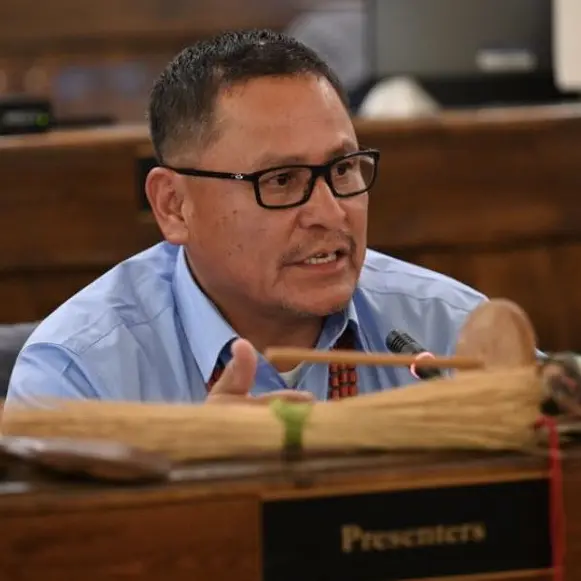*This landing page has been updated to reflect information TNA recently received in a FOIA request and contains information on the original TEP ROW contract with the Navajo Nation*

Did you know Tucson Electric Power (TEP) is requesting a transmission line right-of-way (ROW) renewal from the Navajo Nation? To find out more, read the information below.
Part 1: TEP and Navajo
Tucson Electric Power, established in 1892, is a utility company based in Tucson, Arizona. In the 1960s, in anticipation of shortages, TEP began to shift from using primarily natural gas and fuel oil to including coal in its energy mix. This led to the construction of the Four Corners power plant near Farmington, New Mexico, in 1965.
In 1969, TEP expanded its plans for additional coal-fired electricity by becoming co-owner of San Juan Generating Station, followed by Navajo Generating Station. To get electricity from northern New Mexico to southern Arizona (where TEP’s customer base is located), a 500-mile transmission line was constructed. 102 miles of this transmission line crosses 14 different Navajo Chapter boundaries between Farmington and Gallup, New Mexico. In 1973, the Navajo Nation granted TEP right-of-way (ROW) easements for this 102-mile section of the transmission line. This original ROW agreement has now expired (after 50 years) and provided the Navajo Nation with one-time payments of $269,090.50 and $38,244 for reseeding. 242 allottees shared $110,000 in ROW payments. These seem like small payments, considering TEP made $1.6 billion in revenue in 2024 alone and a net profit of $250 million.
For nearly half a century, TEP and other utilities have benefited from discounted rates and subsidized water and coal in their leases with the Navajo Nation. Taking advantage of tribal resources and denying the Navajo Nation the ability to transition their economy after coal plant closures. To address the economic loss from recent coal plant closures, the Navajo Nation tried to secure direct transition support from TEP through a recent rate case in Arizona. However, that request was denied despite the company claiming to support transition funding for coal-impacted communities.
Now, Tucson Electric Power (TEP) is requesting a right-of-way (ROW) renewal from the Navajo Nation for its transmission line, which cuts across Navajo lands. Navajo, why do you continue to concede and support projects from disingenuous partners like TEP?
Part 2: Navajo Chapters in the ROW
The affected Navajo Chapters in the ROW are: San Juan, Sheep Springs, Twin Lakes, Hogback, Naschitti, Rock Springs, Nenahnezad, Tohatchi, Red Rock, Sanostee, Mexican Springs, Chichiltah, Newcomb, Coyote Canyon. Do you see your chapter on this list?

According to the Navajo Nation Minerals Department and Tucson Electric Power (TEP) all the following chapters have passed supporting resolutions for the ROW renewal. However, less than 15 people voted on this matter from each chapter. Is this adequate community consent? About half of the affected chapters didn’t accept TEP’s pre-scripted generic resolution as it was presented. Instead some of the chapters justifiably included language requesting direct community benefits. Will TEP honor this request from the chapters? The ROW was originally authorized by the Navajo Nation for TEP back in 1973 which consists of a parcel of land 102-miles long, 330-feet wide, and 4,080 acres*. This land currently has two parallel 345 kilovolt (kV) transmission lines and appurtenant wireless telecommunication sites within it. Aside from 14 chapters, there are 11 allotments within the ROW. TEP applied for a renewal of the land right with no change in use, location, or width. *TEP website indicates the acres is 4,072.


Credit U.S. National Park Service
This original ROW agreement provided the Navajo Nation with one-time payments of $269,090.50 and $38,244 for reseeding. 242 allottees shared $110,000 in ROW payments. This equates to about $1.32 per acre per year over the course of 50 years (the duration of the initial agreement), whereas the Bureau of Land Management rented out lands in Navajo and Coconino County for $4.49 per acre per year back in 1987. Contact your chapter and council delegate and ask them to request direct community benefits from Tucson Electric Power (TEP). Be on the lookout for upcoming legislation to the Resource and Development Committee (RDC) and voice your concerns via the 5-day commenting period. Legislations Found Here: dibb.nnols.org/publicreporting.aspx
Here is a chance for our Navajo Nation leaders to stop complaining about the $40 million dollar shortfall from the closure of the Navajo Generating Station and make up for it by re-negotiating a better deal with TEP. Will the Navajo Nation seize this opportunity? Or will the Navajo Nation continue to give land and natural resources away for next to nothing?
Part 3: Call to Action
Tucson Electric Power (TEP) became a subsidiary of Fortis in 2014. Fortis is Canada’s largest investor-owned gas and electric distribution utility, with total assets of approximately $17.6 billion as of 2013. Fortis serves over 2.4 million customers across Canada, New York State and the Caribbean. Rather than conducting community engagement in this ROW renewal process themselves, Tucson Electric Power has contracted Sonoran Land Resources, LLC to act as its right-of-way (ROW) agent and carry out the community engagement process with the 14 chapters in the transmission line route.
For the past 2 years, Sonoran Land Resources, LLC has been getting resolutions from the affected chapters. Most of the chapter resolutions that were passed had 15 people or fewer present during the chapter meeting and final vote. Is this adequate community representation on an issue of this magnitude? Is more community engagement needed? According to Sonoran Land Resources, LLC, there are allottees within the ROW. Allottees are supposed to receive the same payment per acre as the Navajo Nation. So far, more than 50% of allottees have consented.
Involved Allotments in numerical order:
- 1446
- 1487
- 1497
- 1499
- 1507
- 1508
- 217151
- 220254
- 246542
- 246757
- 246758
If you have concerns or questions regarding the ROW specifically, contact:
- Sonoran Land Resources, LLC at 520-829-6169
- TEP directly at (844) 343-1303
- Navajo speakers call (505) 947-2282
Council Delegates who represent the impacted chapters:
Amber Crotty

acrotty@navajo-nsn.gov
Sheep Springs, Sanostee
Rickie Nez

rickienez@navajo-nsn.gov
San Juan, Hogback, Nenahnezad, Newcomb
Nathan Notah

nathan.notah@navajo-nsn.gov
Twin Lakes, Naschitti, Tohatchi, Mexican Springs, Coyote Canyon
Lester Yazzie

lesteryazzie@navajo-nsn.gov
Rock Springs, Red Rock, Chichiltah
How long will our Navajo leaders fuss about a 40 million dollar shortfall from the closure of Navajo Generating Station when they continue to negotiate poorly on deals that could make a meaningful difference in Navajo lives? This matter will need to be submitted to the Resource and Development Committee (RDC) for review and approval as legislation. Please contact RDC to express your concerns and consider providing comments on this legislation when it becomes available. Legislations are posted here: dibb.nnols.org/publicreporting.aspx
Navajo Nation Resources & Development Committee
Brenda Jesus

brenda.jesus@navajo-nsn.gov
Casey Allen Johnson

casey.johnson@navajo-nsn.gov
Danny Simpson

danny.simpson@navajo-nsn.gov
Shawna Ann Claw

shawna.claw@navajo-nsn.gov
Otto Tso

otso@navajo-nsn.gov
Rickie Nez

rickienez@navajo-nsn.gov















